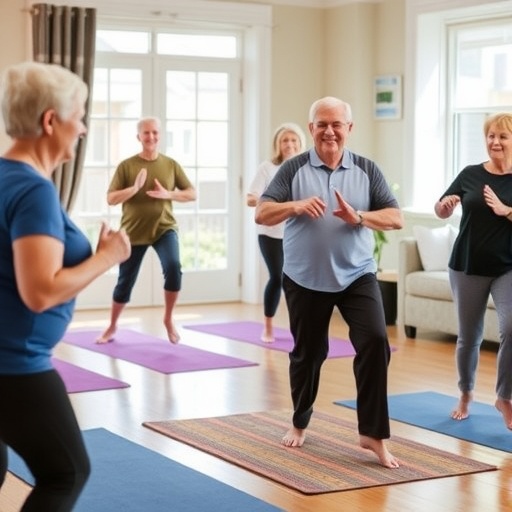In a pioneering study aimed at addressing a pressing health issue, researchers have examined the feasibility of using Kinect technology for home-based aerobic exercise assessment specifically targeted at pre-frail older adults living in community settings. Pre-frailty is a significant concern among older populations as it represents a transitional stage, wherein individuals are at an increased risk of progressing to frailty. The researchers, Huang, Du, and Cherng, have ventured into uncharted territory by leveraging interactive gaming technology to promote health and wellness among this vulnerable demographic.
With an ever-aging global population, the need for innovative approaches to assess and promote physical activity among older adults has never been greater. Traditional methods of evaluating fitness often require visits to clinical settings, which can be daunting or inaccessible for individuals with mobility issues or those living alone. The Kinect technology, originally developed for interactive gaming, offers a unique solution by providing a user-friendly interface that can be utilized in the comfort of one’s home. This study not only focuses on assessing aerobic capacity but also addresses the broader implications for enhancing physical activity engagement among older adults.
The implementation of Kinect technology involves sophisticated motion sensing that can accurately capture and analyze an individual’s movements during aerobic exercises. This capability allows for real-time feedback, which is crucial for promoting safe exercise practices. Unlike conventional assessment methods that may rely on subjective self-reports or cumbersome equipment, Kinect provides an immediate visual assessment of participant performance. Such innovation can empower older adults to monitor their progress, thereby motivating them to adhere to an exercise regimen.
In their study, Huang and colleagues conducted a series of assessments involving various aerobic exercises that are commonly recommended for older adults. This included walking, cycling, and step patterns designed to mimic activities of daily living. By employing Kinect, the researchers were able to objectively measure key variables such as aerobic endurance, balance, and overall mobility. The findings suggested that participants who engaged in regular assessment via Kinect showed significant improvements in their physical capacity over time, highlighting the potential of this technology as an effective tool for promoting health.
An integral aspect of the study was its emphasis on participation and compliance. Many older adults face barriers to exercise, including fear of injury or lack of motivation. The interactive nature of Kinect proved to be a game-changer, transforming mundane exercise routines into engaging experiences. Participants reported higher satisfaction levels and greater willingness to partake in activities when facilitated through gaming technology. This not only enhances their physical health but also fosters a sense of social connection, as many older adults often experience feelings of loneliness.
The implications of this research extend beyond individual assessments; they touch upon broader community health dynamics. Enabling older adults to exercise independently may alleviate some pressure on healthcare systems by reducing frailty-related complications. Following the introduction of the study, community health stakeholders are beginning to recognize the significance of integrating technology into health frameworks for aging populations. The ultimate goal is to create supportive environments that encourage active lifestyles among older individuals.
In terms of technical specifications, the Kinect system utilizes a combination of RGB cameras and depth sensors to create a 3D representation of the user’s movements. The data collected by the Kinect system is analyzed using proprietary algorithms that interpret these movements in real time. This sophisticated analysis generates valuable metrics, allowing for personalized feedback and targeted exercise recommendations based on individual performance levels.
Moreover, the study advocates for further research to explore the long-term sustainability of at-home exercise programs facilitated by technology. Future studies may investigate the potential for group exercises conducted remotely, fostering community bonds while adhering to physical distancing guidelines. Such an approach would not only impact physical health but also address mental health concerns that often accompany social isolation in older adults.
As it stands, the feasibility of using Kinect for aerobic exercise assessment marks a transformative step within geriatric health. This research is not merely an academic exercise; it holds real-world implications that could revolutionize the way we interact with fitness technologies in later life. The adoption of such tools may pave the way for a new standard of care in which technology acts as a supportive ally in the quest for longevity and quality of life.
Huang, Du, and Cherng’s insights into the nexus of technology, exercise, and aging form a compelling narrative that resonates with current trends in health and wellness. As we move forward, the collaboration between technology developers and healthcare professionals will be crucial in designing systems that are not only innovative but also tailor-fit to meet the needs of older adults.
In summary, the research establishes the groundwork for a healthy, more active future for older individuals, driven by technological advancements. By offering a feasible, enjoyable, and effective means of assessment, Kinect technology represents a beacon of hope in tackling the challenges posed by an aging population. It exemplifies how we can harness modern innovations to enhance well-being, proving that the intersection of technology and health can yield powerful outcomes.
As the demographic landscape continues to evolve, this study underscores the urgent need for continued exploration into diverse strategies for promoting healthy aging. It is imperative that researchers, practitioners, and policymakers collaborate to further develop and optimize technologies that support the physical, mental, and emotional well-being of older adults.
The potential for Kinect-based exercise assessments is an exciting frontier that promises to empower older adults, improve health literacy, and ultimately foster a more active and engaged society.
Subject of Research: The feasibility of home-based aerobic exercise assessment for pre-frail older adults using Kinect technology.
Article Title: Feasibility study of kinect home-based aerobic exercise assessment for pre-frail community-dwelling older adults.
Article References:
Huang, WY., Du, YC. & Cherng, RJ. Feasibility study of kinect home-based aerobic exercise assessment for pre-frail community-dwelling older adults.
J. Med. Biol. Eng. 45, 407–415 (2025). https://doi.org/10.1007/s40846-025-00959-y
Image Credits: AI Generated
DOI: https://doi.org/10.1007/s40846-025-00959-y
Keywords: Kinect technology, aerobics, older adults, pre-frailty, health assessment, home-based exercise.




